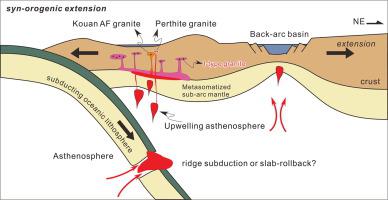Gondwana Research ( IF 6.1 ) Pub Date : 2022-07-16 , DOI: 10.1016/j.gr.2022.07.007 Xing Cui , Min Sun , Guochun Zhao

|
We conducted a detailed comparative study on the petrogenesis of three types of granites in the southern Chinese Altai, using a multi-faceted approach including petrology, whole-rock and mineral chemistry, and zircon Hf-O isotopic analysis. The perthite granites and alkaline feldspar granites from Kouan Pluton are peralkaline and aluminous A-type granites, respectively. They formed coevally in an extensional event during the late Devonian to early Carboniferous orogenic period. The peralkaline granites have distinctly high total alkali, FeOt/(FeOt + MgO), incompatible elements, and low Ba, Sr, Eu contents. They are anhydrous and reduced, possessing high zircon εHf(t) of 9.5–14.3 and zircon δ18O of 5.41–7.81‰. Petrological and chemical analyses suggest that they were formed by extensive differentiation from an enriched mantle-derived alkali basalt. The aluminous A-type granites show chemical features transitional between the peralkaline granites and the Xibodu I-type granites mentioned below. The geochemical and zircon isotopic data (εHf(t) = 8.3–15.1; δ18O = 6.39–8.70 ‰) imply their derivations from the mixture of evolved alkaline magma and juvenile crustal melts. The Xibodu granites were emplaced later (ca. 270 Ma) and have arc-like trace element signatures, with zircon εHf(t) of 8.0–13.2 and δ18O of 5.92–7.84 ‰. We interpret that they originated from anatexis of the juvenile lower crust during the post-collisional extension. Some of them show chemical compositions similar to the Kouan aluminous A-type granites such as high alkali, FeOt/(FeOt + MgO), HFSE and REE, which was a result of high fractionation possibly facilitated by the high temperature and volatile contents. Nevertheless, comparisons of field, mineralogical, and geochemical data show that A-type granites are a distinctive group of granites formed from melts with lower H2O and oxygen fugacity and higher temperature than ordinary granites, while the tectonic setting is not directly related to rock types in nature.



























 京公网安备 11010802027423号
京公网安备 11010802027423号